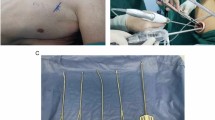Abstract
Objective
The aim of this study was to explore clinical value of thoracic small incision in radical operation for lung and esophageal cancer in assuring same treatment effects with conventional incision.
Methods
Collected data of patients was given radical operation for lung and esophageal cancer in our department from January 1, 2006 to January 1, 2007, and performed retrospective analysis, among them, small incision group (improved group) was 143 cases, and conventional group was 167 cases including 6 cases which was changed from small incision to conventional incision in operation. Compared operation time, incision length, intraoperative blood loss, postoperative drainage flow, number of lymph node dissected, recovery time of postoperative upper limb function, postoperative pain, postoperative complications etc. between both groups.
Results
Compared with conventional group, intraoperative blood loss, postoperative drainage flow, postoperative pain, recovery time of postoperative upper limb function in improved group was improved significantly, and there was no obvious difference in operation time and number of lymph node dissected between both groups.
Conclusion
Small incision in radical operation for lung and esophageal cancer is small trauma, and quick recovery after operation, treatment effects of it is basically similar to that of conventional operation method, however, its application is limited in few cases.
Similar content being viewed by others
References
Zhou NK, Tian XD, Cui ZH, et al. The use of small-sized thoracotomy in minimally invasive thoracic surgery. Med J Chin PLA (Chinese), 2002, 27: 346–347.
Wang X, Huang ZF, Rong TH, et al. Clinial value of modified thoracotomy for thoracic tumors. Chin J Lung Cancer (Chinese), 2001, 4: 426–428.
Akcali Y, Demir H, Tezcan B. A technique facilitating muscle-sparing thoracotomy. Asian Cardiovasc Thorac Ann, 2002, 10: 194–195.
Kutlu CA, Akin H, Olcmen A, et al. Shoulder-girdle strength after standard and lateral muscle-sparing thoracotomy. Thorac Cardiovase Surg, 2001, 49: 12–14.
Khan IH, McManus KG, McCraith A, et al. Muscle sparing thoracotomy: a biomechanical analysis conrrms preservation of muscle strength but no improvement in wound discomfort. Eur J Cardiothorac Surg, 2000, 18: 656–661.
Dave HH, Buechel ER, Prêtre R. Muscle-sparing extrapleural approach for the repair of aortic coarctation. Ann Thorac Surg, 2006, 81: 243–248.
Schreiber C, Bleiziffer S, Kostolny M, et al. Minimally invasive midaxillary muscle sparing thoracotomy for atrial septet defect closure in prepubescent patients. Ann Thorac Surg, 2005, 80: 673–676.
Author information
Authors and Affiliations
Corresponding author
Rights and permissions
About this article
Cite this article
Lu, D., Wang, D., Han, K. et al. Clinical application of thoracic small incision in radical operation for lung and esophageal cancer. Chin. -Ger. J. Clin. Oncol. 8, 596–598 (2009). https://doi.org/10.1007/s10330-009-0134-3
Received:
Revised:
Accepted:
Published:
Issue Date:
DOI: https://doi.org/10.1007/s10330-009-0134-3




